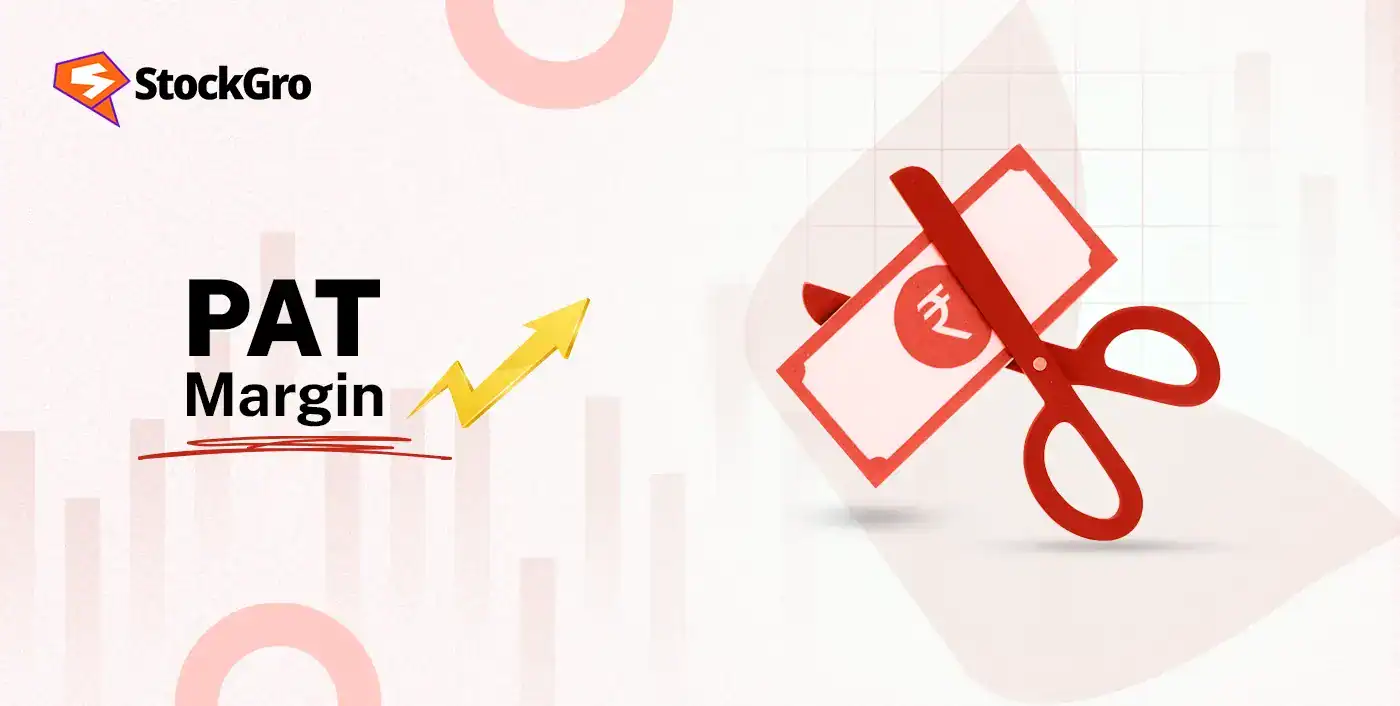
As the market moves fast, ups and downs in profit reported by a company can significantly influence the investors’ sentiment and its share prices, which reminds us how tightly market reactions are tied to a company’s profitability.
Profit After Tax (PAT) Margin shows how much of every rupee earned by a company actually remains as profit once all costs, interest, and taxes are settled. It’s a significant metric of how efficiently a business converts revenue into earnings, and it is mostly the first number investors watch when results roll in.
When this margin narrows, as in the case of Bandhan Bank, even revenues may fail to reassure investors, while a rising margin signals strength, efficiency, and better long-term potential.
Read this blog to know what is PAT Margin, how it’s calculated, and why it plays a decisive role in shaping a company’s financial standing and market perception.
What is PAT Margin?
Profit after tax (PAT) margin is a financial ratio that indicates the percentage of total revenue of a company, which is the net profit, after all the expenses. Expenses have been deducted including interests, and taxes.
It is a metric for investors that provides insights into a company’s financial, operations, and profitability, especially when a company issues shares through an IPO. It is the final earnings available to the shareholders or a factor that decides reinvestment in the company.
The formula for calculating PAT margin is,
Profit after tax (PAT) Margin = (PAT/Total Revenue) x 100
And, PAT is calculated as,
PAT = Total Revenue – (Operating Expenses + Interest + Taxes + Depreciation & Amortisation)
Let’s take an example, suppose a company reports a total revenue of ₹500 crore. Its operating expenses, interest, taxes, and depreciation together amount to ₹450 crore.
Then,
PAT = ₹500 crore – ₹450 crore = ₹50 crore
PAT Margin = (₹50 crore / ₹500 crore) × 100 = 10%
Why PAT Margin Matters
- True Profitability Measure: It provides an actual view of a company’s profitability by accounting for all the costs, including taxes.
- Performance Assessment: A higher PAT margin indicates better cost management and an efficient business model.
- Investment Decisions: Investors and analysts use metrics, including PAT margin, to compare a company’s performance over different periods and against peers within the same industry to make effective investment decisions.
- Dividend Capacity: It directly influences the amount of profit available for dividend distribution to the shareholders.
Components / Drivers of PAT Margin
The components or drivers of PAT margin interact to influence the profitability of a company. Here’s a breakdown of each component:
Revenue / Sales Growth
Revenue or sales is the total value generated by a company from sales of goods or services. The increase in the revenue, without an increase in the costs reflecting economies of scale, leads to a higher PAT margin, providing a larger base for distributing fixed costs.
For example, let’s say a smartphone company increases its annual sales from ₹100 crore to ₹150 crore by introducing a popular mid-range model, while its fixed costs remain the same. The resulting economies of scale would push its PAT margin higher.
Operating Expenses & Overheads
The costs incurred from the normal business operations, such as cost of goods sold (COGS), salaries, rent, utilities, and marketing, are called operating expenses and overheads. While managing these costs effectively is important, lower operating expenses increase both operating profit and the PAT margin.
For example, a clothing manufacturer switches from imported to locally sourced fabrics, which cuts material costs by 10%. So, with consistent sales, its lower expenses increases the overall PAT margin.
Interest, Depreciation & Taxes
Interest, depreciation, and taxes are expenses that are accounted for after calculating the operating profit but before arriving at the net profit, which are significant deductions. Lower interest costs might be due to less debt, managed depreciation, and effective tax planning can improve the final PAT margin.
For example, a logistics company refinances its high-interest loan at a lower rate, which reduces its annual interest expenses by ₹50 lakh. This reduction directly increases its PAT margin without changing the revenue or operational efficiency.
Non-Recurring Items & Adjustments
These are gains or losses that occur for a single time in a long period of time, such as the sale of an asset, restructuring costs, impairment charges, or legal settlements. However, these may cause a significant impact on the PAT margin of a particular period, making it less representative of the company’s basis, ongoing profitability. The analysts or investors adjust for these items for a better understanding of a company’s performance.
For example, an IT company sells an old office building and records a one-time gain of ₹2 crore. While the PAT margin appears higher for that quarter, this is not an indicator of sustainable profitability.
PAT Margin vs Other Margins
The distinction between PAT margins and other margins lies in which expenses are deducted from the total revenue to arrive at the specific margin.
Here’s a comparison table for a clear understanding!
| Margins | Focus | Formula | Expenses included |
| Gross margin | It focuses on production and pricing efficiency | Gross margin = Gross Profit/Total Revenue x 100 | Cost of Goods Sold (COGS) |
| EBITDA margin | It focuses on the operational efficiency such as cash flows, or tax decisions | EBITDA Margin = EBITDA/Total Revenue x 100 | COGS and operating Expenses, excluding interest, taxes, depreciation & amortization |
| Operation margin | It focuses on operational efficiency using standard accounting principles such as GAAP | Operating Margin = Operating Profit/Total Revenue x 100 | COGS, and Operating Expenses, including Depreciation & Amortization, but excluding interest, taxes, and non-operating expenses |
| PAT margin | It focuses on profitability for stakeholders. | PAT Margin = Profit after tax/Total Revenue x 100 | It include all expenses: COGS, Operating Expenses including Depreciation & Amortization, Interest, Taxes, and all other income or expenses |
How to Calculate PAT Margin (Step-by-Step)
Here’s an example of how PAT margin is calculated.
Example with Numbers
LG Electronics India Ltd. Summary of Statement of Profit and Loss for FY 2025.
| Particular | Amount (₹ lakh) |
| Revenue from operations | 2,43,666.38 |
| Other income | 2,639.90 |
| Total income | 2,46,306.28 |
| Expenses: | |
| Cost of materials consumed | 1,47,405.50 |
| Purchases of stock-in-trade | 19,729.36 |
| Changes in inventories | (1,333.98) |
| Gross Margin | 80,505.40 |
| Employee benefits expenses | 9,627.94 |
| Other expenses | 37,136,25 |
| EBITDA | 33,741.21 |
| Depreciation and amortisation | 3,803.57 |
| Operation profit (EBIT) | 29,937,64 |
| Finance cost | 306.46 |
| Profit before tax (PBT) | 29,631.11 |
| Tax expenses | 7,597.63 |
| Profit after tax (PAT) | 22,033.48 |
Trend over Time & Growth Rate
The PAT margin trend involves comparing the PAT margin across multiple time periods, such as annually for several years or quarterly, to identify patterns of increasing, decreasing, or stagnation of profitability.
The trend over time and the growth of PAT margin are calculated as
Year-on-year (YoY) growth = (Current Year PAT Margin – Previous Year PAT Margin)/Previous Year PAT Margin x 100
Where, PAT Margin = PAT/Total Revenue x 100
2025 PAT Margin = (22,033.48 / 243,666.38) x 100 = 9.04 %
2024 PAT Margin = (15,110.68 / 213,520.00) × 100 = 7.08 %
So for LG Electronics, PAT Margin Growth Rate (YoY) = (9.04 – 7.08)/7.08 x 100 = 27.7%
Benchmark / What is a “Good” PAT Margin?
The benchmark or ‘good’ PAT margin is determined based on market forces and industry averages, and it varies across sectors and companies. While there is no regulatory body that sets a benchmark for PAT margin, there is this rough rule of thumb that says:
- Below 5%: It is considered low, and it may indicate financial struggles or risk.
- Around 10%: It is considered average or healthy.
- 20% or above: It is considered very optimistic or high.
How to Improve PAT Margin
Improving the Profit After Tax (PAT) margin may involve a combination of revenue enhancement and cost management strategies. Let’s break them down!
Cost Optimization
Cost optimization may involve negotiating better supplier terms, streamlining operations, reducing overhead costs, and adopting automation to cut expenses, while enhancing efficiency and improving overall profitability.
Pricing & Premium Strategies
Pricing and premium strategies focus on value-based pricing and premium positioning to enhance revenue, and by analysing price elasticity, companies can find the optimal balance between price and demand.
Tax Planning & Efficiency
Tax planning and efficiency involve using available tax credits and deductions, optimising the business structure, and timing major expenses strategically. For global firms, cross-border tax planning helps in minimising overall tax liabilities.
Focus on Core Operations
Focusing on core operations means divesting non-core assets, streamlining the product portfolio, and improving efficiency in main business areas, which sharpens quality, increases profitability, and strengthens customer loyalty.
Conclusion
The PAT margin gives the picture of how much profit a company keeps from its revenue after deducting every expense and tax. A steady or rising PAT margin reflects efficiency, cost control, and sustainable growth, while a falling margin may indicate rising costs or weak pricing power. Understanding PAT margin helps investors and management to analyse long-term financial stability and the true earning potential of a business.
FAQ‘s
The PAT margin is a financial ratio that measures how much of a company’s total revenue remains as profit after all expenses, interest, and taxes are deducted. It helps to measure profitability and financial efficiency over time.
A company can improve its PAT margin by cutting operational costs, optimising prices, managing taxes, and focusing on its most profitable operations to strengthen overall performance.
PAT margin reflects how efficiently a company converts its total revenue into net profit. And it is calculated as, PAT Margin = (Profit After Tax ÷ Total Revenue) × 100
Yes, non-recurring items are included in the PAT margin, but analysts mostly adjust them separately to understand the company’s actual profitability and get a clear picture of performance.
A good PAT margin varies by industry. Generally, below 5% is considered low, around 10% is healthy, and 20% or above indicates a strong and profitable business model.
Yes, higher tax rates reduce net profit, which directly reduces the PAT margin. The companies plan taxes efficiently to manage these tax liabilities and maintain stable profitability.
The operating margin measures profit before interest and taxes, focusing on operational efficiency. Whereas PAT margin includes all the expenses, giving the final measure of overall profitability.

